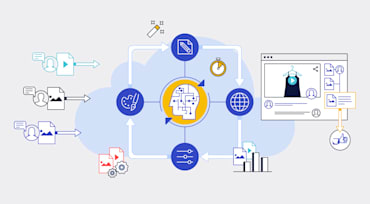No matter your business focus—public service, B2B integration, recruitment—multimedia, in particular video, is remarkably effective in communicating with the audience. Before, making video accessible to diverse viewers involved tasks galore, such as eliciting the service of production studios to manually dub, transcribe, and add subtitles. Those operations were costly and slow, especially for globally destined content.

Artificial intelligence (AI), machine learning, virtual reality, the so-called metaverse—it can be tough to keep tabs on the development of technologies. In particular, for businesses or brands characterized by highly visual experiences—retail, entertainment, travel and hospitality, and so forth—identifying which technologies to prioritize is challenging.

As online interactions multiply exponentially, visual media has become the most significant venue for delivering the benefits of what used to be in-person contacts. With this in mind, companies have completely shifted their digital strategies for consumer experiences, taking a media-first approach in how they interact and engage.

In today’s digital world, engaging online content is key for catching audience attention. At ImageCon 2020, Cloudinary’s annual conference, Yaron Reichert and me, Jackie Rosenzveig, hosted a session titled ’Handling Media at Scale Using Automation and AI’, which delved into the following:

These days, e-commerce websites are trending clean and sleek, almost always spotlighting high-quality product photos with a flat-white, solid-color, or transparent background. Many practical and well-validated reasons support this choice, making it clear that this is no passing fad. This graphic illustrates a few of them:

It’s human nature for most to want a sneak peek at upcoming content whenever possible. Think movie trailers or the “on next week’s episode” part of your favorite show. For video producers, an essential goal is to attract more views and clickthroughs.

If you're the developer for an online store, a news site, a social media app, or any other website that delivers new media content on a regular basis, you are probably painfully familiar with both the challenge and importance of delivering well-cropped images.

Automating the organization of your website’s media assets (images and videos) saves time and money, boosting the usefulness and lengthening the life span of those assets. Cloudinary’s artificial intelligence (AI) driven automatic tagging, transcription, and moderation capabilities ably and efficiently handle that automation for you—at scale.

Images and videos are critical for ensuring user engagement on the web. For instance, on a retail website, images of a product from different angles or a 360-degree video of the product can lead to higher conversion rates. For a news website, users are more likely to read articles with visual media accompanying the content. It has been reported that posts that include images produce a 650-percent higher user-engagement rate than text-only posts.

Individuals and organizations constantly face a plethora of passport-related issues, ranging from identity theft to impersonations and other vices. As an individual, you could be denied a job or visa just because of a minor noncompliance with the complex requirements for your passport photo. To avoid falling victim to such situations, you need an elaborate measure that ensures that your passport photo meets those requirements without fail.
